| ILFORD Ilfomatics |
|
|
|
||
|
|
|||
|
The Ilfomatic camera range was one of simple plastic construction cameras taking the 126 Instamatic film cartridge, sold from 1967 (maybe late 1966) to the end of December 1969. Clearly of lower cost construction than the Sportsman 126 cameras, they look similar to the contemporary Kodak Instamatic cameras (introduced mid-1963) but were somewhat cheaper and of less solid construction. They were made in Hong Kong. The Ilfomatic Universal Flash camera (left, above), was introduced in July 1968 and advertised as "a cartridge-loading camera especially made for the person who just wanted a point & shoot camera." No settings were possible, there was simply a single element f11 meniscus fixed focus lens in a single speed shutter. It measured 100 x 65 x 50mm, similar to the equivalent Kodak Instamatic, and was claimed to be "very light weight ~ only a few ounces". The built-in flashcube fitting automatically rotated the cube when the film was wound on. All the range had double exposure prevention, a thumb wheel film advance and a clear optical viewfinder (in fact just plain clear plastic defining the field of view). Finished in silver and black, the Ilfomatic Universal Flash initially cost £3.12s.7d (£3.63p) with an ever ready case being an additional 15s.3d (76p). The Universal Flash was also available in an outfit comprising the camera, a wrist strap, an Ilford Super Colorprint cartridge film, 3 flash cubes and 2 batteries, costing £4.10s.10d (£4.54p). The Ilfomatic Universal 50C (above right) was also introduced in July 1968 to replace the Ilfomatic Universal 50 (see below). It also had a built-in flash cube socket, but was otherwise more complex, having a two speed shutter and a two element 49mm f11 glass lens with 2 aperture settings ~ sunny or cloudy/flash. There was a built-in power supply via 2 AAA batteries. The 50C was priced at £4.19s.8d with wrist strap (£4.98p), and the case was 17s.9d extra (89p). Amateur Photographer magazine for 3rd December 1969 also lists the Ilfomatic Compact camera (background to right hand picture, above), with a retail price of £2.14s (£2.70p). The Compact version was the simplest of all the Ilfomatics. It had a fixed aperture lens, single speed shutter and only an accessory shoe to enable taking flash pictures by means of a separate flash gun. |
|||
| The top central black socket is for a flash cube. The black button in the central upper rear of the camera body (see right hand picture) is the flash cube eject button. The right hand picture also shows the thumb wheel film wind on, the viewfinder back sight and a label bearing the information that the flash range is 4-9feet with colour film and 4-15feet with black & white film. The slide-up opening in the left hand side of the camera body is where the 2 off AAA battery cells are inserted to fire the flash cube. | |||
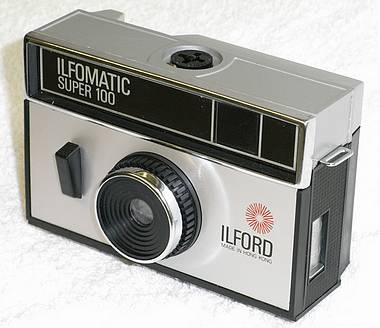 |
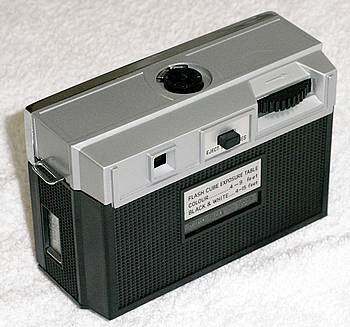 |
||
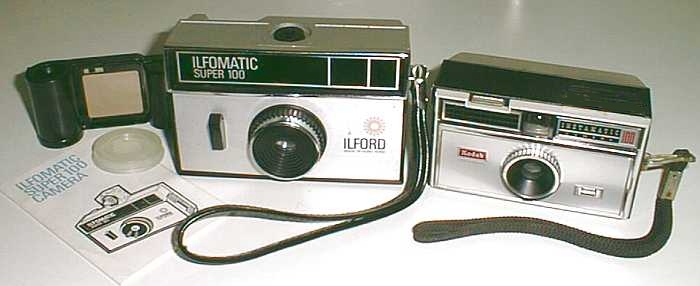 |
|||
| The above picture compares an Ilfomatic Super 100, which has a socket to take flash cubes, with a Kodak Instamatic 100 which has a built-in retractable flashgun taking AG-1 size bulbs. Both cameras have battery compartments to accomodate 2 AAA size cells. The Ilford measures 118mm long (cf 104mm for the Kodak) by 78mm tall (cf 63mm) by 60mm deep incl. the lens (cf 52mm). Both have a fixed aperture lens and single speed shutter (though the Kodak shutter slows automatically from 1/90th sec to 1/40th sec when the flash gun is raised for use). The Kodak is a much nicer camera to hold, being smaller and with a better, more 'solid', standard of construction, while costing only a little more than the Ilford. The Instamatic 100 cost just short of £5 in mid-1963 when the range was first announced. | |||
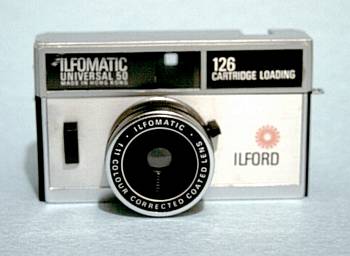 |
The Ilfomatic Universal 50 (left) was very similar to the 50C (top right above), having a two speed shutter and a two element 49mm f11 glass lens, with 2 aperture settings, sunny or cloudy/flash. The difference is that the 50C was equipped for flash cubes whereas the 50 required a separate flash gun, fitted into the centre contact accessory hot-shoe. The Universal 50C replaced the Universal 50 in July 1968 (ref: 'Photography' magazine). Thanks to Lance Williams I know that the Universal 50 measures 115mm long x 68mm tall x 61mm deep incl the lens (39mm excl the lens), so this camera, although smaller than the Super 100 (above), was still larger than the equivalent Kodak Instamatic.
|
||
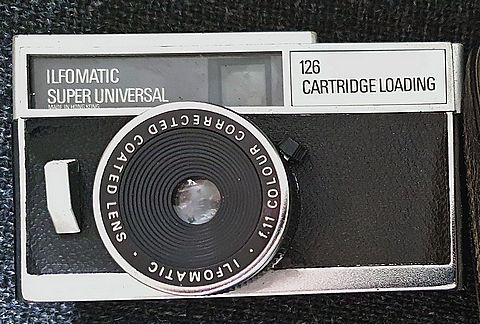 |
Alongside is shown the Ilfomatic Super Universal, also equipped for flash cube photography. Not much is known about this model. Andy Holliman suggests it may just be a better finished version of the Universal 50C, see picture at top right of this page. For the picture alongside, I am grateful to Phil Robinson. |
||
|
In Amateur Photographer (AP) for 3rd December 1969 these cameras are being heavily discounted. The Ilfomatic Universal Flash (top left hand picture) is being sold as part of a gift outfit, including the camera, flashcubes & batteries, at £3.9s.6d (£3.48p), against a claimed retail price of £5.0s.11d (£5.05p). The 50C camera alone is priced at £2.5s (£2.25p). Cases are offerd at 12s.6d (63p). The Super 100 is being discounted to £2.15s (£2.75p). The reason for the heavy discounting is apparent from AP for 31st December 1969, where it is announced that the range of Ilfomatic 126 cameras and outfits will no longer be available. Thus, the end of the 1960s probably represents the end of Ilford's amateur camera marketing attempts, some 12-13 years after the Sportsman first appeared. |
|||
|
|
|||
|
|
|||
